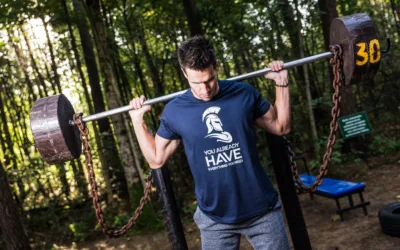Best Neck Exercises for Chronic Neck Pain

Chronic headaches? Stiff neck? Spending too much time on your phone/computer (which is all of us, let’s be honest) puts excess stress on all the wrong muscles. Don’t worry, though – doing a few of these movements as little as twice a week is all you need to get that neck pain to go away. For good.
Fred Ormerod is a freelance coach, army reserve medic, nurse, master’s student, and masseuse. He’s spent a decade working in healthcare and five years coaching in one of Edinburgh’s leading training facilities. Here he explains the most common causes of neck pain and what you can do to fix it.
Don’t forget to check out his program Train Your Neck for an easy-to-follow 6-week plan to alleviate neck pain & prevent injury!
Fred Ormerod




Change the Way You Train
You Need To Train Your Neck. Here’s Why.
There are lots of reasons to train your neck. On an aesthetic level (especially in sports such as bodybuilding), a thick neck helps round out your upper-body physique. In sports such as Muay Thai or wrestling, neck strength can help in performance.
But neck strengthening isn’t just for athletes. I believe everyone needs to strengthen their neck for both injury prevention and pain relief.
One of the most common things I see in my clinic is something I affectionately call “tech neck.” This is caused by excess stress on the levator scapula from spending hours on your computer or phone.
Sound like you? Don’t worry. “Tech neck” is easily prevented by training the deep neck tissues to hold up your head instead of compensating with superficial muscles (like the levator scapula and traps).
What’s Causing Your Neck Pain
Chronic neck tension and injury are often associated with shoulder, elbow, and wrist pain. It’s always the first place I look if a client complains of shoulder pain. Sometimes the cause of neck pain is actually tight trap muscles caused by long-term compensation somewhere in the shoulder joint.
Nearly 75% of all chronic neck issues come from an imbalance between upper- and lower-trapezius muscles. This often leads to pain all over the neck, shoulders, chest, arms, and back.
In order of importance, I recommend working the following muscles:
- Lower traps
- Rotator cuff
- Pec minor
- Teres Minor
- Upper traps
- Deltoids
If you’re a regular gym attendee, you probably work these muscles already. Just make sure you work through the widest range of motion possible (that doesn’t cause any pain) for each set.
How to Do Neck Workouts the Right Way
So how do you get started training your neck?
The key is to train your smaller, deep, cervical neck muscles in a way that doesn’t overstimulate the larger muscles. So start light with your neck training.
Target Small & Big Muscle Groups
Use flexion, extension, and rotation exercises in equal volume to target smaller, deep neck muscles, and shrugs, rows, and deadlifts to target larger muscle groups (such as your traps).
This gets the most out of your neck training without risking injury to weaker muscles or overworking your traps (especially if you’re already loading them regularly in training/sport).
The movements I recommend are:
- Flexion (moving your chin down and back)
- Rotation/anti-rotation (turning your head, not your chest, left and right)
- Extension (chin back and down)
- Isometric catch (catching a light weight against the front side and back of the head, usually in a seated position)
Use Plate Loading
Plate loading your neck workouts is beneficial for a few reasons:
- It’s easier to progressively overload your training when you know exactly what weight you’re lifting (rather than holding an arbitrary banded/isometric load).
- It’s easier to isolate smaller muscle groups in the head and get a better range of motion in the neck.
- Plate-loaded systems are more effective at activating neck muscles such as the sternocleidomastoid (scm) and in increasing strength and durability in these areas.
I do occasionally like to include a swiss ball and bands. But the bulk of training should be plate loaded and measurable.
The beauty of training your neck is that you’ve likely never done it before, so you can expect to see positive results pretty fast (gotta love those newb gains). Also, no one ever asks “what’s your 1RM on cable neck curls,” so it’s a great exercise to take the ego out of your training.
Stay Consistent!
Training your neck as little as two sets twice per week produces good results in injury prevention and pain relief. I usually start athletes off with two sets of 10-15 reps twice per week, which gets results and takes all of five minutes to complete.
If you are struggling with neck issues or are involved in any kind of contact sport, you should obviously always seek medical advice before taking part in any physical training program. But if you:
- Work at a desk
- Own a laptop or mobile phone
- Drive a lot
- Are stressed and suffering from migraines
- Are worried about concussions
then try doing these movements a few times a week and feel the pain melt away (or prevent it from ever happening!).
Find Your Perfect Training Plan
Sometimes all you need to reach your destination on your fitness journey is an expert guide. We've got you covered. Browse from thousands of programs for any goal and every type of athlete.
Try any programming subscription free for 7 days!
Want Training Tips, Exercise Guides & Knowledge Bombs Sent to Your Inbox?
Sign up for the FitNerd newsletter from TrainHeroic
Related articles
Slow Reps vs. Fast Reps
You’ve probably noticed that some people in the gym tend to perform their reps as fast as possible, whereas others take a slow and controlled approach. But which is better? Dr. Andy Galpin is a Professor of Kinesiology at the Center for Sport Performance at California...
How to Do Leg Extensions Without a Machine
Short shorts are the new stinger tanks. Rocking those big tree trunks with canyon deep cuts is so hot. Leg extensions are a bodybuilding staple—they isolate your quads, the front-facing muscle group of your thighs, by flexing (bending) and extending (straightening)...
Tried-and-True Methods to Fix Plantar Fasciitis
What is Plantar Fasciitis? If you’re new to running or returning to it after a break, you might have been blighted by plantar fasciitis, a fancy name for an annoyingly common foot problem. It’s when the band of tissue that connects your heel to your toes (the plantar...


Join the community
Sign up for the latest training news and updates from TrainHeroic


About TrainHeroic
Made with love, sweat, protein isolate and hard work in Denver, CO
© 2023 TrainHeroic, Inc. All rights reserved.






